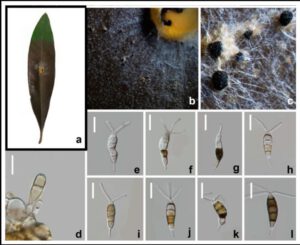Neopestalotiopsis terricola Li W.L. & Jian K. Liu, in Li, Dissanayake, Zhang, Maharachchikumbura & Liu, Journal of Fungi 8(11, no. 1175): 14 (2022)
Index Fungorum number: IF 845408; MycoBank number: MB 845408; Facesoffungi number: FoF 12748;
Etymology – Named referring the habitat of this fungus, terrestrial
Holotype – HKAS 123213
Pathogenic on diseased branches of Paeonia suffruticosa Andr. Sexual morph: Not observed. Asexual morph: Conidiomata globose, solitary, semi- immersed, black, excluding dark brown to black masses of conidia. Conidiophores indistinct, often reduced to conidiogenous cells. Conidiogenous cells 2.5–3.5 × 2–3 μm (x̄ = 3 × 2.5 μm, n = 30), mostly integrated, ampulliform to lageniform, hyaline, smooth-walled, single, with truncated apex. Conidia 20–23 × 8–9.5 μm (x̄ = 21.5 × 8.5 μm, n = 30), fusoid, ellipsoid, straight to slightly curved, 4 septa; conical to obconical basal cell with a truncated base, hyaline, rough and thin-walled, 3–4 μm long, often with a small basal appendix; three medial cells with light brown to dark pigmentation with a rough wall (second cell from the base pale brown, 4–5 μm; third cell golden brown 5–6 μm long; fourth cell brown, 4.5–5 μm long); apical cell of 2.5–4 μm long, hyaline, cylindrical, thin and smooth-walled with 3 apical tubular appendages, not arising from the apical crest, but each inserted at a different locus in the upper half of the apical cell, unbranched, filiform, 15–23 μm; single basal appendix, tubular, unbranched, centric, 4–6 μm, mean conidium length/width ratio = 2.5:1.
Culture characteristics – Colonies on PDA reaching 70 mm diam. after 7 d at 25 ℃. Colonies filamentous to circular, medium dense, with white sparse mycelium, fruiting bodies black.
Material examined – China, Sichuan Province, Mianyang city, on diseased branch of Paeonia suffruticosa, 10 June 2021, W.L. Li, YMD A254 (HKAS 123213, holotype), ex-type living culture, CGMCC 3.23553; ibid., Chengdu city, on diseased leaf of Olea europaea, YMD A254b (HUEST 22.0034, paratype), living culture, UESTCC 22.0034.
Notes – Two strains obtained in the present study clustered closer to Neopestalotiopsis sp.2 (CFCC 54340) and Neopestalotiopsis sp.2 (ZX22B) and there are few base pair differences in ITS, tef1-α and tub2. The median cell of our collection (A254) (isolated from Paeonia suffruticosa) was with darker conidia than those of Neopestalotiopsis sp.2 (BJFC-S1790) which is reported from Castanea mollissima leaves. Another collection isolated from the diseased olive leaves share similar conidial size and color to Neopestalotiopsis sp.2 (BJFC-S1790). Hence, we identified our strains as a new species, namely Neopestalotiopsis terricola.

Figure 3 – Neopestalotiopsis terricola (HKAS 123213) (a). Olea europaea leaves infected by N. terricola (b,c) Conidiomata on infected leaves. (d) Conidiogenous cells and conidia. (e–l) Conidia. Scale bars: (d–l) = 10 μm.
